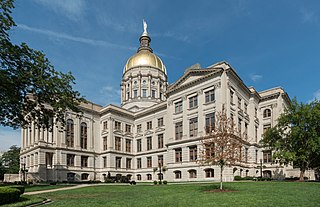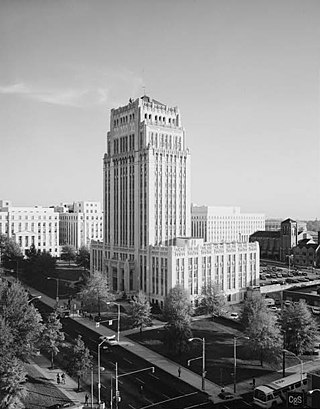
The Georgia State Capitol is an architecturally and historically significant building in Atlanta, Georgia, United States. The building has been named a National Historic Landmark which is listed on the National Register of Historic Places. As the primary office building of Georgia's government, the capitol houses the offices of the governor, lieutenant governor, and secretary of state on the second floor, chambers in which the General Assembly, consisting of the Georgia State Senate and Georgia House of Representatives, meets annually from January to April. The fourth floor houses visitors' galleries overlooking the legislative chambers and a museum located near the rotunda in which a statue of Miss Freedom caps the dome.

Brian Gene Nichols is a convicted murderer known for his escape and killing spree in the Fulton County Courthouse in Atlanta, Georgia, on March 11, 2005. Nichols was on trial for rape when he escaped custody and murdered the judge presiding over his trial, a court reporter, a Fulton County Sheriff's deputy, and later an ICE special agent. Twenty-six hours after a large-scale manhunt was launched in the metropolitan Atlanta area, Nichols was taken into custody. The prosecution charged him with committing 54 crimes during the escape; he was found guilty on all counts on November 7, 2008, and was subsequently sentenced to life in prison.

Druid Hills Historic District is a historic district in Druid Hills and Atlanta in DeKalb County, Georgia, United States, that is listed on the National Register of Historic Places (NRHP).

Atlanta City Hall is the headquarters of the City of Atlanta government. It was constructed in 1930, and is located in Downtown Atlanta. It is a high-rise office tower very similar to dozens of other city halls built in the United States during the same time period. Located in South Downtown, it is near other governmental structures, such as the Georgia State Capitol and the Fulton County Courthouse. The Neo-Gothic structure features many architectural details that have helped to make the building a historical landmark. It is Atlanta’s fourth city hall.

The Georgia Trust for Historic Preservation is the United States' largest statewide, nonprofit preservation organization with more than 8,000 members. Founded in 1973 by Mary Gregory Jewett and others, the Trust is committed to preserving and enhancing Georgia's communities and their diverse historic resources for the education and enjoyment of all.

The Candler Building is a 17-story high-rise at 127 Peachtree Street, NE, in Atlanta, Georgia. When completed in 1906 by Coca-Cola magnate Asa Griggs Candler, it was the tallest building in the city. This location where Houston joins Peachtree Street was the location of one of the earliest churches in the city which was built on land donated by Judge Reuben Cone in the 1840s. It forms the northern border of Woodruff Park.

The Capital City Club is a private social club located in Atlanta, Georgia. Chartered on May 21, 1883, it is one of the oldest private clubs in the South.
William Augustus Edwards, also known as William A. Edwards was an Atlanta-based American architect renowned for the educational buildings, courthouses and other public and private buildings that he designed in Florida, Georgia and his native South Carolina. More than 25 of his works have been listed on the National Register of Historic Places.

The U.S. Post Office and Courthouse, built in 1933, is an historic United States Post Office and federal courthouse building located at 120 12th Street in Columbus, Georgia. It was designed by Atlanta-based architect William Augustus Edwards who designed nine South Carolina courthouses as well as academic buildings at 12 institutions in Florida, Georgia and South Carolina. On September 29, 1980, it was added to the National Register of Historic Places.

The Fannin County Courthouse, built in 1937, is an historic courthouse building located in Blue Ridge, Georgia, United States. It was designed by Atlanta-based architect William Augustus Edwards who designed one other courthouse in Georgia, two in Florida and nine in South Carolina well as academic buildings at 12 institutions in Florida, Georgia and South Carolina. On June 8, 1995, it was added to the National Register of Historic Places.

The City Hall and Firehouse, built in 1914, is an historic city hall and fire station building located on the corner of Crawford and Water streets in Bainbridge, Georgia. It was designed by Atlanta-based architect William Augustus Edwards who designed nine South Carolina courthouses as well as academic buildings at twelve institutions in Florida, Georgia and South Carolina. It is a contributing property in the Bainbridge Commercial Historic District, which was added to the National Register of Historic Places on 6 November 1987.

The Odd Fellows Building and Auditorium, located at 228—250 Auburn Avenue, N.E. in the Sweet Auburn Historic District of Atlanta, Georgia, are historic buildings built in 1912 and 1913, respectively, as the headquarters of the District Grand Lodge No. 18, Jurisdiction of Georgia, of the Grand United Order of Odd Fellows in America. B.S. Ingram was District Grand Master and Dr. William F. Penn was chairman of the building committee. Renowned Atlanta-based architect William Augustus Edwards designed the buildings, while Robert E. Pharrow was the contractor and M.B. Morton was superintendent of construction. Booker T. Washington dedicated the Odd Fellows Building in 1912.

The Dodge County Courthouse is a historic courthouse building located in Eastman, Georgia. Built in 1908, it was designed by Eastman-born American architect Edward Columbus Hosford, who is noted for the courthouses and other buildings that he designed in Florida, Georgia and Texas. The builder was M.L. Lewman & Company. This was the very first courthouse Hosford had ever designed. His commission was controversial because his father, Charlie Columbus Hosford, was a member of the building committee appointed by the county commissioners. Since Edward C. Hosford then lived in Atlanta, it was rumored that he was going to farm the project out to the more experienced architect who had been bypassed in order to give him the commission, but he moved back to Eastman and did all the work himself.

The historic 21-story Rhodes–Haverty Building was, at the time of its construction in 1929, the tallest building in Atlanta, Georgia. Designed by Atlanta architects Pringle and Smith, the building was built by furniture magnates A. G. Rhodes of Rhodes Furniture and J. J. Haverty of Havertys. It remained the tallest building in Atlanta until 1954.

William Lee Stoddart (1868–1940) was an architect who designed urban hotels in the Eastern United States. Although he was born in Tenafly, New Jersey, most of his commissions were in the South. He maintained offices in Atlanta and New York City.

The Elbert P. Tuttle U.S. Court of Appeals Building, also known as U.S. Post Office and Courthouse, is a historic Renaissance Revival style courthouse located in the Fairlie-Poplar district of Downtown Atlanta in Fulton County, Georgia. It is the courthouse for the United States Court of Appeals for the Eleventh Circuit.
Albert Anthony Ten Eyck Brown (1878–1940) was an architect active in Atlanta, Georgia and other areas. Brown was born in Albany, New York. He studied at the New York Academy of Design.

Hotel Indigo Atlanta Midtown is a historic building in midtown Atlanta, Georgia. Designed by Atlanta-based architectural firm Pringle and Smith in 1925, the brick building is located on Peachtree Street, across from the Fox Theatre. It has been listed on the National Register of Historic Places since 2006, and, in 2022, is a member of Historic Hotels of America.

The Carnegie Building is a historic building located at 141 Carnegie Way in downtown Atlanta, Georgia, United States. Built in 1925 as the Wynne-Claughton Building, the 12-story building was designed by architect G. Lloyd Preacher. It was designated an Atlanta Historic Building in 1990 and was added to the National Register of Historic Places in 2012.

The Whitehall Street Retail Historic District is a historic district in Atlanta, Georgia, United States. The district is centered on Peachtree Street and Martin Luther King Jr. Drive and includes Broad, Forsyth, and Mitchell Streets. It was added to the National Register of Historic Places in 2020.























